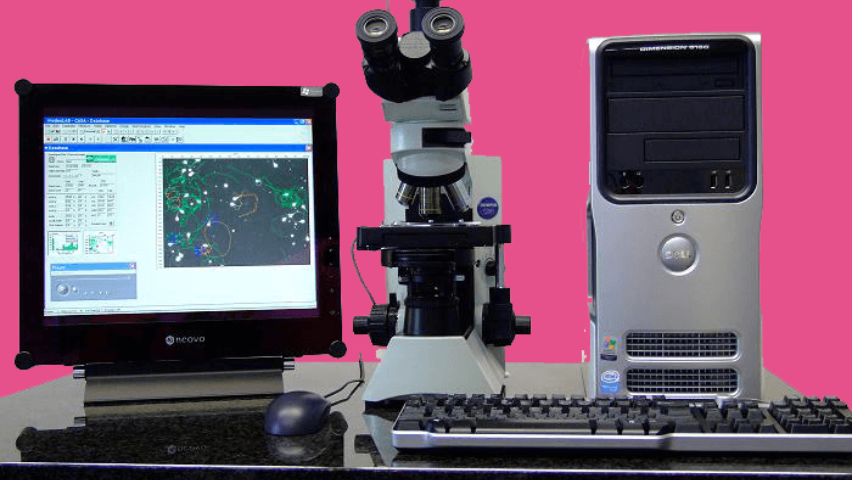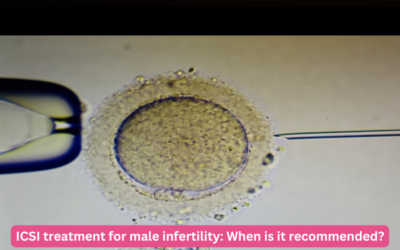What is CASA ?
Computer-Assisted Semen Analysis (CASA) is a technology used in the field of reproductive medicine to assess and analyze sperm parameters in male infertility diagnosis and research. CASA systems utilize computer algorithms and digital imaging to evaluate various characteristics of sperm, including motility (movement), concentration, morphology (shape), and viability. By providing quantitative and objective data, CASA enhances the accuracy and reliability of semen analysis, helping clinicians to identify potential fertility issues and guide appropriate treatments for couples struggling with infertility.
Benefits of Computer-Assisted Semen Analysis (CASA)
The benefits of CASA in male infertility are manifold, offering precise and comprehensive insights into sperm quality and aiding in the diagnosis and treatment of infertility. Here are some key benefits:
- Accuracy and precision: CASA provides highly accurate and objective measurements of sperm parameters such as motility, concentration, morphology, and viability. This helps in eliminating the subjectivity associated with manual semen analysis methods, leading to more reliable results.
- Quantitative data: CASA generates quantitative data on various sperm characteristics, allowing for a thorough assessment of male fertility potential. This detailed information assists fertility specialists in identifying specific issues that may be contributing to infertility.
- Early detection of abnormalities: CASA enables the early detection of abnormalities in sperm parameters, even those that may not be apparent through visual inspection alone. Identifying these abnormalities promptly allows for timely intervention and treatment planning.
- Personalized treatment plans: With the detailed data provided by CASA, fertility specialists can tailor treatment plans to address the specific needs of each individual or couple. This personalized approach increases the likelihood of successful fertility treatments.
- Monitoring treatment progress: CASA can be used to monitor the effectiveness of fertility treatments over time by tracking changes in sperm parameters. This allows for adjustments to treatment protocols as needed, optimizing the chances of conception.
- Research and development: CASA technology plays a crucial role in research and development efforts aimed at understanding male infertility and improving fertility treatments. The data generated by CASA contributes to advancements in reproductive medicine.
- Patient satisfaction and confidence: By offering advanced technology like CASA, fertility clinics can enhance patient satisfaction and confidence in the quality of care provided. Patients appreciate the use of state-of-the-art tools that contribute to more accurate diagnoses and better treatment outcomes.
Advantages of Computer-Assisted Semen Analysis (CASA)
- Objective analysis: CASA provides standardized and objective analysis of sperm parameters, reducing subjectivity.
- Quantitative data: Generates quantitative data on motility, concentration, morphology, and viability for thorough assessment.
- High precision: Offers precise measurements of sperm characteristics, detecting subtle abnormalities.

- Comprehensive assessment: Analyzes multiple parameters simultaneously, offering a complete view of fertility status.
- Efficiency and time-saving: Streamlines analysis process, reducing time and accelerating result turnaround.
- Enhanced diagnostic accuracy: Identifies subtle sperm abnormalities, improving diagnostic accuracy.
- Monitoring treatment progress: Facilitates tracking of treatment effectiveness through changes in sperm parameters.
- Research and advancements: Contributes to research efforts and advancements in understanding male infertility.
Parameters of Computer-Assisted Semen Analysis (CASA)
Computer-Assisted Semen Analysis (CASA) in male infertility evaluates several key parameters to assess sperm quality and fertility potential. These parameters provide valuable insights into the health and functionality of spermatozoa. Here are the main parameters analyzed by CASA:
- Sperm motility: CASA measures the ability of sperm cells to move effectively. Motility is crucial for sperm to travel through the female reproductive tract and fertilize an egg.
- Sperm concentration: CASA quantifies the concentration of sperm cells in the semen sample. This parameter indicates the number of sperm present per milliliter of semen and is essential for determining fertility potential.
- Sperm morphology: CASA assesses the size, shape, and structural integrity of cells. Morphologically normal sperm have a higher likelihood of successfully fertilizing an egg.
- Sperm viability: CASA determines the percentage of viable sperm cells in the sample. Viability indicates whether sperm cells are alive and capable of fertilization.
- Sperm velocity: CASA measures the speed at which sperm cells move, including parameters such as average path velocity (VAP), straight-line velocity (VSL), and curvilinear velocity (VCL). Velocity is critical for sperm to reach and penetrate the egg.
- Sperm linearity: CASA evaluates the straightness of sperm movement, indicating how efficiently sperm cells swim towards their destination. Linearity influences sperm’s ability to navigate through the female reproductive tract.
- Sperm amplitude of lateral head displacement (ALH): CASA measures the magnitude of lateral head displacement during sperm movement. ALH reflects the strength and vigor of sperm tail movements, which are essential for propulsion.
- Sperm beat cross frequency (BCF): CASA assesses the frequency of sperm tail movements, indicating the rapidity of flagellar beating. BCF influences sperm motility and swimming ability.
- Sperm agglutination: CASA detects the presence of sperm clumping or agglutination, which can hinder sperm movement and fertilization. Agglutination may indicate underlying sperm abnormalities or immune system dysfunction.
Process and procedure of Computer-Assisted Semen Analysis (CASA)
The CASA (Computer-Assisted Semen Analysis) process and procedure in male infertility evaluation involve several steps to accurately assess sperm parameters. Here’s a detailed overview:
- Sample collection: The process begins with the collection of a semen sample from the male patient. Proper collection techniques are emphasized to ensure the integrity of the sample.
- Sample preparation: The collected semen sample undergoes preparation, which may involve liquefaction to ensure uniform consistency for analysis. Dilution may be necessary for samples with high sperm concentration.
- Loading the sample: A portion of the prepared semen sample is loaded onto a specialized counting chamber or slide, typically under controlled conditions to maintain sample integrity.
- Microscopic examination: The loaded slide is placed under a microscope equipped with CASA technology. The CASA system captures digital images or videos of cells of the sperm in the sample.
- Sperm analysis: The CASA software analyzes the captured images or videos to assess various parameters of sperm motion, including velocity, trajectory, and frequency. Additionally, it measures sperm concentration, morphology (shape), and viability.
- Data interpretation: Trained professionals interpret the results of the CASA analysis. Parameters such as sperm count, motility percentage, and morphology are evaluated to determine the overall quality of the semen sample.
- Report generation: A comprehensive report detailing the findings of the CASA analysis is generated. This report includes quantitative data on sperm parameters and any abnormalities detected during the analysis.
- Consultation and discussion: The patient meets with a fertility specialist to discuss the results of the CASA analysis. The specialist explains the implications of the findings and discusses potential treatment options based on the patient’s individual circumstances.
- Follow-Up and monitoring: Depending on the results of the CASA analysis and the treatment plan agreed upon, the patient may undergo further monitoring and follow-up appointments to track progress and adjust treatment as necessary.
- Continued support: Throughout the CASA process and beyond, the patient receives ongoing support from the fertility clinic staff. This may include guidance on lifestyle modifications, emotional support, and access to additional fertility services as needed.
Preparation For The CASA
Preparation for the CASA (Computer-Assisted Semen Analysis) test involves several steps to ensure accurate and reliable results. Here’s a guide to preparing for the CASA test:
- Abstaining from ejaculation: It’s recommended for the male patient to abstain from ejaculation for a period of 2 to 5 days before the CASA test. This period of abstinence helps to ensure a sufficient sperm count and optimal sperm motility for analysis.
- Avoiding Certain substances: To obtain accurate results, the patient should refrain from consuming alcohol, tobacco, caffeine, and recreational drugs for at least 48 hours before the CASA test. These substances can affect sperm quality and may interfere with the analysis.
- Informing the laboratory: It’s important to inform the laboratory or fertility clinic conducting the CASA test of any medications or supplements the patient is taking. Certain medications and supplements can influence sperm parameters and may need to be temporarily discontinued before the test.
- Providing a fresh sample: The semen sample for the CASA test should be collected through masturbation into a clean, sterile container provided by the laboratory or clinic. It’s essential to collect the sample directly into the container without using any lubricants or condoms, as these can interfere with the analysis.
- Avoiding contamination: Care should be taken to avoid contamination of the semen sample during collection. Hands should be thoroughly washed with soap and water before collecting the sample, and the container should be tightly sealed after collection to prevent leakage or contamination.
- Transporting the sample: The semen sample should be transported to the laboratory or clinic for analysis as soon as possible after collection. It’s recommended to keep the sample at body temperature during transport to maintain sperm viability.
- Providing relevant information: The patient should provide any relevant medical history or information about previous fertility testing or treatments to the laboratory or clinic conducting the CASA test. This information helps the healthcare provider interpret the results accurately.
FAqs
Is CASA more accurate than traditional semen analysis methods?
Yes, CASA is generally considered to be more accurate and reliable than traditional manual semen analysis methods due to its objective and standardized approach.
How long does a CASA test take?
The duration of a CASA test may vary depending on the laboratory or clinic performing the analysis. Typically, results are available within a few hours to a day after sample collection.
Is there any preparation required for a CASA test?
Yes, preparation for a CASA test may include abstaining from ejaculation for a period of 2 to 5 days, avoiding certain substances like alcohol and tobacco, and providing relevant medical history to the healthcare provider.
Can CASA results predict fertility success?
CASA results provide valuable information about sperm quality and fertility potential, but they cannot guarantee fertility success. The interpretation of CASA results should be done in conjunction with a thorough clinical evaluation by a fertility specialist.
Where can I get a CASA test done?
CASA tests are typically available at fertility clinics, reproductive health centers, and laboratories specializing in reproductive medicine. It’s recommended to consult with a healthcare provider or fertility specialist to schedule a CASA test.
How accurate is CASA in predicting fertility outcomes?
CASA provides valuable information about sperm quality and fertility potential, but it is not the sole determinant of fertility success. Other factors such as female reproductive health, sperm-egg interaction, and overall health of both partners also play significant roles in fertility outcomes.
Can medications or lifestyle factors affect CASA results?
Yes, certain medications, lifestyle factors (such as smoking or excessive alcohol consumption), and environmental exposures can impact sperm parameters and may influence CASA results. It’s important to inform the healthcare provider of any relevant factors that may affect sperm quality.
Meet Our Specialists

Dr. Prakash Patel
MBBS, DGO, Diploma in Laparoscopy, Diploma in Fetal Medicine
Specialities: IVF, Male Infertility, Female Infertility
Experience: 10+ years
Language: English, Hindi, Gujarati
- Expert in advanced laparoscopic surgeries.
- Successfully manages complex IVF cases and recurrent miscarriages.
- Proficient in high-risk pregnancy and advanced IVF treatments.
- Compassionate, personalized patient care.
- Certified by top institutions in France and Croatia.
- Member of FOGSI and ISAR, recognized internationally.

Dr. Ajay Prajapati
MBBS (Bachelor of Medicine, Bachelor of Surgery), MS (Master of Surgery)
Specialities: IVF, Infertility, Fetal medicine
Experience: 10+ years
Language: English, Hindi, Gujarati
- Over a decade of hands-on experience in fertility and pregnancy challenges.
- Expert in advanced laparoscopy for minimally invasive surgeries.
- FOGSI-certified sonologist, ensuring accurate pregnancy assessments.
- Known for successful outcomes and trusted care in high-risk cases.
- Earned patient trust across Gujarat and beyond
Testimonials
Blogs related to Male Infertility
ICSI treatment for male infertility: When is it recommended?
Male infertility affects many couples worldwide, making natural conception a challenge. Recent advancements in reproductive technologies have...
Understanding your sperm analysis report: What do the numbers mean?
A sperm analysis is a critical part of the fertility evaluation process, especially for couples undergoing IVF treatment. Receiving a sperm analysis...
Tips to Improve Oligospermia(Low Sperm Count)
Oligospermia, or low sperm count is a common concern for many men facing fertility issues. It refers to having fewer sperm cells in the ejaculate...
How Can Testosterone Affect Male Infertility?
Testosterone is often hailed as the cornerstone of male virility and health. It plays a critical role in the development of male reproductive...
The Relationship Between Stress and Infertility
Infertility is a challenge that affects millions of couples worldwide, often bringing with it a rollercoaster of emotions. While the physical...
Explaining Unexplained Infertility and Its Management
Unexplained infertility is a term that can bring both relief and frustration to couples struggling to conceive. Relief because no serious...
Latest Techniques in Male Infertility Diagnosis
-Targeted information on the cause of male infertility through effective testing techniques is at the core of successfully treating it. -The goal of...
Difference between TESA, TESE, MESA, PESA?
Sometimes, during ejaculation, although men produce seminal fluid, a semen analysis test can reveal the absence of sperm in this ejaculated semen...
Zero sperm count? What next?
Zero sperm count in ejaculation is known as Azoospermia. A man with azoospermia has no measurable sperm in his ejaculate (semen). A sperm production...
Why Male and Female infertility is increasing nowadays?
Male and female infertility is caused by certain medical issues that prevent them from becoming pregnant. India has an alarming increase in...










